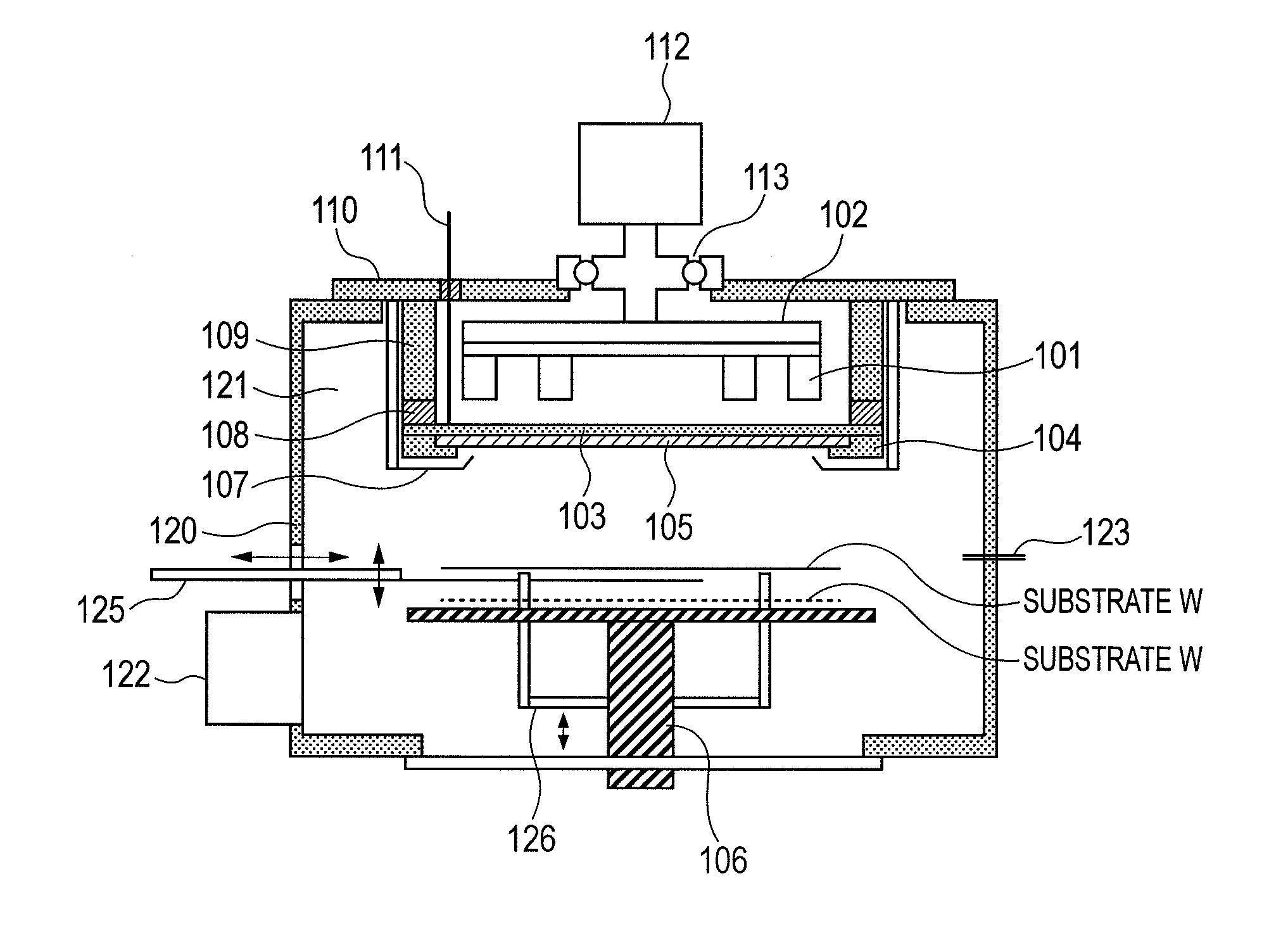Magnet unit and magnetron sputtering apparatus
a magnet unit and sputtering technology, applied in the direction of magnets, magnet bodies, vacuum evaporation coatings, etc., can solve the problems of difficult to project an erosion point, uneven erosion, and eroded target surface with elapsed operation time, so as to prolong the target life and reduce the parallel rotation of the magnet unit. , the effect of reducing the magnetic track region
- Summary
- Abstract
- Description
- Claims
- Application Information
AI Technical Summary
Benefits of technology
Problems solved by technology
Method used
Image
Examples
example 1
[0084]Regarding the mode shown in FIG. 10 to which an embodiment of the present invention can be applied, the shape of the magnetic track and the magnetic flux density were confirmed and also the erosion shape was confirmed. The yoke 712 including iron as a main component (Japanese Industrial Standards SS400) has a diameter of 370 mm and a thickness of 10 mm. The magnet element 7011, which has a length of 100 mm, a width of 70 mm, and a height of 37 mm, the magnet element 7012, which has a length of 150 mm, a width of 40 mm, and a height of 37 mm, and the magnet element 7013, which has a length of 150 mm, a width of 40 mm, and a height of 37 mm, are fixed onto the yoke 712 with epoxy series adhesive for constituting the internal magnet 701. The outer surface of the internal magnet unit 701 is assumed to have the S-pole (i.e., adhesion surface of the yoke 712 has the N-pole). The external magnet unit 702 (outer surface has the N-pole) is fixed onto the yoke 712 with the epoxy series ...
example 2
[0088]This time, a magnetic target 1502 of iron-cobalt alloy (saturation magnetic flux density: 2.4 T) is disposed close to the magnet unit shown in Example 1 and the magnetic track shape and the magnetic flux density were confirmed and also the eroded shape was confirmed on the magnetic target 1502. Here, the target has a diameter of 380 mm and a thickness of 3 mm, and the distance between the surface of the magnet unit and the surface of the magnetic target 1502 is 16 mm.
[0089]At this time, the magnetic track shape appearing on the magnetic target 1502 was confirmed and a result was obtained as shown in FIG. 14. Further, a region, where a magnetic field component parallel to the surface of the magnetic target 1502 was equal to larger than 50 mT, was obtained as shown in FIG. 15, and it was confirmed that a magnetic flux density enabling stable discharge was obtained also on the magnetic target in the magnet unit to which an embodiment of the present invention could be applied.
[009...
example 3
[0091]FIG. 17 shows a magnet unit of a seventh example which is a modification of the magnet unit of the first example shown in FIG. 2. The feature of the magnet unit of the seventh example shown in FIG. 17 is the following point. An internal magnet unit 401 (e.g., S-pole) includes three magnet elements 4011, 4012, and 4013 which extend radially in at least n-directions (n=3) from the radial center 4100 which coincides with the rotation center of the yoke. Meanwhile, an external magnet unit 402 (e.g., N-pole) has a (3n−1) or more-angular shape (3×3−1=8) which are arranged so as to surround the above three magnet elements 4011, 4012, and 4013 and includes (3n−1) external magnets (3×3−1=8) 4021 to 4028. In such a configuration, the above three magnet elements 4011, 4012, and 4013 are arranged in the circumferential direction having angles of 90 degrees, 90 degrees, and 180 degrees in between, respectively.
[0092]Note that, also in the magnet unit of the seventh example shown in FIG. 17...
PUM
| Property | Measurement | Unit |
|---|---|---|
| angle | aaaaa | aaaaa |
| angle | aaaaa | aaaaa |
| diameter | aaaaa | aaaaa |
Abstract
Description
Claims
Application Information
 Login to View More
Login to View More - R&D
- Intellectual Property
- Life Sciences
- Materials
- Tech Scout
- Unparalleled Data Quality
- Higher Quality Content
- 60% Fewer Hallucinations
Browse by: Latest US Patents, China's latest patents, Technical Efficacy Thesaurus, Application Domain, Technology Topic, Popular Technical Reports.
© 2025 PatSnap. All rights reserved.Legal|Privacy policy|Modern Slavery Act Transparency Statement|Sitemap|About US| Contact US: help@patsnap.com



